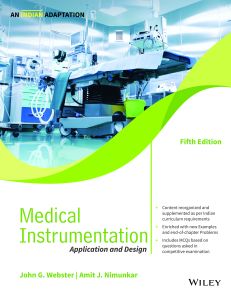Medical Instrumentation 5ed: Application and Design, An Indian Adaptation
ISBN: 9789354249150
656 pages
For more information write to us at: acadmktg@wiley.com

Description
This Indian adaptation of the fifth edition of the book builds on the conceptual strength of the original to include new topics and reorganization of some existing for better alignment with Indian curriculum requirements. Basic concepts are supplemented with new topics on Receiver Operating Characteristics, and Quality Assurance and Quality Improvement. The book offers enhanced coverage of the developing fields of medical instrumentation, such as Biosensors, Electronic Opto-isolators, Biotelemetry, Gamma Cameras, and Microcontrollers – including their hardware, data transfer, and new biomedical applications.
1 Basic Concepts of Medical Instrumentation
1.1 Terminology of Medicine and Medical Devices
1.2 Generalized Medical Instrumentation System
1.3 Alternative Operational Modes
1.4 Medical Measurement Constraints
1.5 Classifications of Biomedical Instruments
1.6 Interfering and Modifying Inputs
1.7 Compensation Techniques
1.8 Basic Concepts of Biostatistics
1.9 Receiver Operating Characteristics (ROC)
1.10 Generalized Static Characteristics
1.11 Generalized Dynamic Characteristics
1.12 Design Criteria
1.13 Commercial Medical Instrumentation Development Process
1.14 Quality Assurance and Quality Improvement
1.15 Regulation of Medical Devices
2 Amplifiers and Signal Processing
2.1 Ideal Op-Amps
2.2 Inverting Amplifiers
2.3 Noninverting Amplifiers
2.4 Differential Amplifiers
2.5 Instrumentation Amplifier
2.6 Comparators
2.7 Rectifiers
2.8 Logarithmic Amplifiers
2.9 Integrators
2.10 Differentiators
2.11 Electronic Opto-Isolator
2.12 Active Filters
2.13 Frequency Response
2.14 Offset Voltage
2.15 Bias Current
2.16 Input and Output Resistance
2.17 Phase-Sensitive Demodulators
2.18 Timers
3 Basic Sensors and Principles
3.1 Displacement Measurements
3.2 Resistive Sensors
3.3 Bridge Circuits
3.4 Impedance Bridge Circuits
3.5 Inductive Sensors
3.6 Capacitive Sensors
3.7 Piezoelectric Sensors
3.8 Accelerometer
3.9 Temperature Measurements
3.10 Thermocouples
3.11 Thermistors
3.12 Radiation Thermometry
3.13 Fiber-Optic Temperature Sensors
3.14 Optical Measurements
3.15 Radiation Sources
3.16 Introduction to Biosensors
3.17 Geometrical and Fiber Optics
3.18 Optical Filters
3.19 Radiation Sensors
3.20 Optical Combinations
4 Microcontrollers In Medical Instrumentation
4.1 Introduction to Microcontrollers
4.2 Basics of Embedded Medical System
4.3 Microcontroller Based ECG System-an Example of Embedded Medical System
4.4 Development of Embedded Medical System
4.5 IoT-Based Medical Devices
5 The Origin Of Biopotentials
5.1 Electrical Activity of Excitable Cells
5.2 Volume Conductor Fields
5.3 Functional Organization of the Peripheral Nervous System
5.4 The Electroneurogram
5.5 The Electromyogram
5.6 The Electrocardiogram
5.7 The Electroretinogram
5.8 The Electroencephalogram
5.9 The Magnetoencephalogram
6 Biopotential Electrodes
6.1 The Electrode–Electrolyte Interface
6.2 Polarization
6.3 Polarizable and Nonpolarizable Electrodes
6.4 Electrode Behavior and Circuit Models
6.5 The Electrode–Skin Interface and Motion Artifact
6.6 Body-Surface Recording Electrodes
6.7 Internal Electrodes
6.8 Electrode Arrays
6.9 Microelectrodes
6.10 Electrodes for Electric Stimulation of Tissue
6.11 Practical Hints in Using Electrodes
7 Biopotential Amplifiers
7.1 Basic Requirements
7.2 The Electrocardiograph
7.3 Problems Frequently Encountered
7.4 Transient Protection
7.5 Common-Mode and other Interference-Reduction Circuits
7.6 Amplifiers for other Biopotential Signals
7.7 Example of a Biopotential Preamplifier
7.8 Other Biopotential Signal Processors
7.9 Cardiac Monitors
7.10 Biotelemetry
7.11 Applications of Biotelemetry
8 Chemical Biosensors
8.1 Blood-Gas and Acid-Base Physiology
8.2 Electrochemical Sensors
8.3 Chemical Fibrosensors
8.4 Ion-Sensitive Field-Effect Transistor (ISFET)
8.5 Immunologically Sensitive Field-Effect Transistor (IMFET)
8.6 Noninvasive Blood-Gas Monitoring
8.7 Blood-Glucose Sensors
8.8 Electronic Noses
8.9 Lab-On-a-Chip
8.10 Summary
9 Blood Pressure and Sound
9.1 Direct Measurements
9.2 Harmonic Analysis of Blood Pressure Waveforms
9.3 Dynamic Properties of Pressure-Measurement Systems
9.4 Measurement of System Response
9.5 Effects of System Parameters on Response
9.6 Bandwidth Requirements for Measuring Blood Pressure
9.7 Typical Pressure-Waveform Distortion
9.8 Systems for Measuring Venous Pressure
9.9 Heart Sounds
9.10 Phonocardiography
9.11 Cardiac Catheterization
9.12 Effects of Potential and Kinetic Energy on Pressure Measurements
9.13 Indirect Measurements of Blood Pressure
9.14 Tonometry
10 Measurement of Flow and Volume Of Blood
10.1 Indicator-Dilution Method That Uses Continuous Infusion
10.2 Indicator-Dilution Method That Uses Rapid Injection
10.3 Electromagnetic Flowmeters
10.4 Ultrasonic Flowmeters
10.5 Thermal-Convection Velocity Sensors
10.6 Chamber Plethysmography
10.7 Electrical-Impedance Plethysmography
10.8 Photoplethysmography
11 Measurements Of The Respiratory System
11.1 Modeling the Respiratory System
11.2 Measurement of Pressure
11.3 Measurement of Gas Flow
11.4 Lung Volume
11.5 Respiratory Plethysmography
11.6 Some Tests of Respiratory Mechanics
11.7 Measurement of Gas Concentration
11.8 Some Tests of Gas Transport
12 Clinical Laboratory Instrumentation
12.1 Spectrophotometry
12.2 Automated Chemical Analyzers
12.3 Chromatology
12.4 Electrophoresis
12.5 Hematology
13 Medical Imaging Systems
13.1 Information Content of an Image
13.2 Modulation Transfer Function
13.3 Noise-Equivalent Bandwidth
13.4 Medical Imaging System
13.5 Enhancement of Medical Images
13.6 Medical Image Denoising
13.7 Radiography
13.8 Computed Radiography
13.9 Computed Tomography
13.10 MRI Reconstruction Techniques
13.11 Magnetic Resonance Imaging
13.12 Nuclear Medicine
13.13 Gamma Camera
13.14 Single-Photon Emission Computed Tomography
13.15 Positron Emission Tomography
13.16 Ultrasonography
13.17 Contrast Agents
14 Therapeutic And Prosthetic Devices
14.1 Cardiac Pacemakers and Other Electric Stimulators
14.2 Defibrillators and Cardioverters
14.3 Mechanical Cardiovascular Orthotic and Prosthetic Devices
14.4 Hemodialysis
14.5 Lithotripsy
14.6 Ventilators
14.7 Infant Incubators
14.8 Drug Delivery Devices
14.9 Surgical Instruments
14.10 Therapeutic Applications of the Laser
15 Electrical Safety
15.1 Physiological Effects of Electricity
15.2 Important Susceptibility Parameters
15.3 Distribution of Electric Power
15.4 Macroshock Hazards
15.5 Microshock Hazards
15.6 Electrical-Safety Codes and Standards
15.7 Basic Approaches to Protection Against Shock
15.9 Protection: Equipment Design
15.10 Electrical-Safety Analyzers
15.11 Testing the Electric System
15.12 Tests of Electric Appliances
15.13 Testing of Electromagnetic Interference (EMI)
15.13 Conclusion
Appendix
A.1 Physical Constants
A.2 International System of Units (SI) Prefixes
A.3 International System of Units
A.4 Abbreviations
A.5 Chemical Elements
Index

